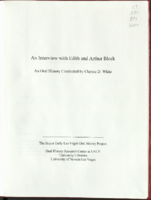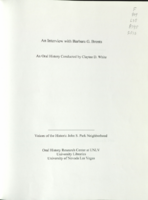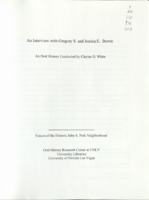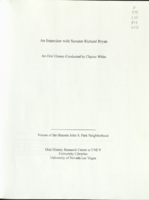Search the Special Collections and Archives Portal
Search Results

Transcript of interview with Edith and Arthur Bock by Claytee White, September 15, 2009
Date
2009-09-15
Archival Collection
Description
Arthur and Edith Block share memories of their respective childhoods in northern Nevada (Arthur) and East Chicago, Indiana (Edith). Sixty-three years of marriage encompasses Edith's career in banking and Arthur's work in the dry cleaning business and as a highway patrolman. It was his career in law enforcement that drew them to Las Vegas in 1968. Recalling Las Vegas in the sixties and seventies, Edith and Arthur discuss their first home, the hotels and entertainers, integration, and Howard Hughes. They talk about train service, agriculture, Basque influence, and the Thunderbirds in northern Nevada, and what it was like to live in those small rural towns. In contrast, they mention the downtown renovation, heavy traffic, explosive growth, and entertainment options in Las Vegas. In addition to their careers and raising a family, Edith and Arthur talk about their involvement with their church, which provides outreach programs and a certified day school. Arthur mentions working as security for the Summa Corporation after he retired from law enforcement, and Edith provides details about her work in banking. They also comment on the future of Las Vegas/Clark County and express their love for the state of Nevada.
Text

Transcript of interview with Cynthia Cicero, Tina Boag, Betty Brown, and Jan Ravetti by Claytee D. White, March 28, 2014
Date
2014-03-28
Archival Collection
Description
Four women, Cynthia Cicero, Betty Brown, Tina Boag, and Jan Ravetti, recall coming to Las Vegas to obtain jobs during the period of mob ownership in the Las Vegas hotels. Each had a different reason for coming. A recession in Buffalo, New York, brought Cynthia and her husband to Las Vegas to obtain employment; Jan Ravetti’s family moved from Pennsylvania due to her father’s illness and possible employment; parents of Tina Boag, who was born in Paris, were entertainers who travelled and performed extensively; and Milton Prell, opening the Aladdin Hotel and Casino, encouraged Californian Betty Brown to work for him. Cynthia Cicero obtained a job with the City of Las Vegas, but the other three worked on the Strip in the casinos. Their experiences in the hotels show the differences between mob and corporate management since they were working there before and after Howard Hughes purchased six of the large Vegas hotels. The four ladies tell about their work on the Strip from Betty’s experience as a genie at the Aladdin to Tina’s position as a twenty-one dealer. They were acquainted with the casino owners and managers, entertainers like Sammy Davis, Jr. and Dean Martin, and show girls. They also knew first-hand the interactions between mobsters and the public. Food, for example, was a giveaway, an enticement for people to come into the hotel to gamble. They also knew stories about high rollers, the robbery of the baccarat tables at Caesars Palace, and the importance of “taking a fall” including the rewards attached. The ladies describe the shops on downtown Fremont Street and the Strip such as Nina Clark’s, Ronzones, Dillards and Chic Hecht’s as well as Penneys and Sears. A young woman shopped at Suzie Cream Cheese, for example, for the right outfit to wear to Pussy Cat A Go-Go, the rock and roll club on the Strip. Las Vegas also had many good gourmet and ethnic restaurants, piano bars, hotel lounges, and pubs with excellent entertainment. The ladies also describe the difference in the treatment of women during the 1960s and 1970s by men in clubs. Women rarely bought drinks nor did they pay for dinners when with gentlemen. Finally, the ladies compare areas where they lived including McNeil Estates, Heritage Square and the Chisholm-built homes in the Jones-Vegas Drive area. Not to be forgotten, however, are the terrible rain storms that flood streets and the Strip. Serious gamblers in the casinos refused to leave the tables while drenching rains washed cars from the hotel parking lots during the 1970s. Neither did they leave the MGM casino when the hotel caught on fire in1980.
Text

Transcript of interview with Barbara G. Brents Claytee D. White, January 12, 2010
Date
2010-01-12
Archival Collection
Description
When Barbara Brents and her husband Mike moved to Las Vegas in 1987, she had no desire to call it home. It was part of a life adventure, an enchantment with the "Old West" and about a job at UNLV. Sure it wasn't the ivy covered campus, but "the kitsch of Las Vegas was kind of the appeal." Living in John S. Park Neighborhood proved to have a charm on the couple, who have lived in three different homes there. One had a view of Bob Stupak's World of Las Vegas sign and another was used in a scene for the television series Nasty Boys. Their current home was previously owned by Berkeley Bunker, a former U.S. Senator. Over the years they have enticed others to live in John S. Park and continue live there themselves. Barbara shares historic footnotes, political stories, and what lead up to the historic districting of the neighborhood she so dearly cherishes. As she says, "The reason I like Las Vegas is this neighborhood, and I would be gone in a second if this neighborhood died."
Text

Transcript of interview with Patricia Deverell by Patrick Kiser, April 26, 1986
Date
1986-04-26
Archival Collection
Description
Patrick Kiser interviews Patricia Deverell (b. 1929) in her home about her experiences while growing up in Nevada after arriving in 1937. Patricia discusses the various population and climate changes that she has witnessed, as well as major events such as the above-ground atomic testing. Patricia also mentions her occupation in the gaming industry and describes some of those changes over time.
Text

Transcript of interview with Greg and Jessia Brown by Claytee D. White, March 1, 2009
Date
2009-03-01
Archival Collection
Description
Greg Brown arrived in Las Vegas in 1998 to take a position with the history department at UNLV. His future wife had lived here off and on as a child and relocated back to Las Vegas in 2000. In 2002 the couple purchased a home in John S. Park neighborhood. Living in John S. Park Neighborhood can be simultaneously frustrating and wonderful from their point of view. They share thoughts and observations about their experiences on a range of topics, including: local politics and redevelopment, the importance of Mid-Century Modern architecture, the obsolete utility poles, neighborhood beautification, First Fridays, and safety efforts.
Text

Transcript of interview with Lisa Brown by Barbara Tabach, August 19, 2013
Date
2013-08-19
Archival Collection
Description
Lisa Brown was very thoughtful in selecting to move into the Scotch 80s neighborhood. Her home on Bannie Street was built in 1959 and is an example of the popular midcentury modern design. The Scotch 80s is snug in its matured landscaping. At the same time, Lisa describes a view of the Stratosphere from her backyard. Her neighbors represent a list of longtime residents (across the street neighbors Carolyn and Oscar Goodman—current and former Las Vegas mayors). Lisa Brown, who has lived in Las Vegas two times since 1996 and continuously for the past eleven years, talks about the decision to relocate from guard-gated Henderson communities. Though her friends questioned why, she firmly believes that she has found the place she will live for decades to come. In 2010, Lisa began an over one-year renovation of the house. Working as her own contractor and using local design experts, she was adamant about preserving the essence of the house’s architectural design. She is only the third owner of the property and felt a responsibility to maintain a connection to the house’s previous owners. She shares anecdotes of how she did that, how she maintained the original footprint and only added a few square feet.
Text

Transcript of interview with Senator Richard Bryan by Claytee White, February 19, 2009
Date
2009-02-19
Archival Collection
Description
Senator Richard Bryan's Las Vegas roots are deep. His father graduated from Las Vegas High School in 1927, left to attend law school and later returned with his young family. His father was politically active and a role model for young Richard, who would succeed in becoming Governor of Nevada in the 1980s and then U.S. Senator. In this interview, Senator Bryan describes his parents looking at a plat map of John S. Park in 1943 and that they bought a house on Maryland Parkway for around $5500.00. He recounts details of the John S. Park neighborhood development and nearby areas and talks about houses with carports rather than garages, no grass, rough asphalt driveways, and a desert where kids could play for hours without supervision. He mentions the impact of World War II on the community, attending movies at the Huntridge Theatre, and becoming a student leader as well as being active in the Boy Scouts. About the Helldorado Days, he talks about the large undertaking of the parade for the Elks Club. As Las Vegas' population grew, the neighborhoods began to fill in. He tells of the opening of schools, including permanent JSP Elementary in 1948 - with no air conditioning. Neighborhood commerce included a grocery store and Sills Drive-in. On the Strip, he remembers Club Bingo (eventually called Sahara) opening as well as the long list of other hotel/casinos that are part of Las Vegas history.
Text

Transcript of interview with John F. Cahlan by Lester Wisbrod, February 18, 1975
Date
1975-02-18
Archival Collection
Description
John Cahlan (1902-1988) discusses his experiences in journalism, including his work as an editor for the Review Journal. Cahlan is interviewed by Lester Wisbrod. He provides details on some of the major events covered by the newspaper, such the building of the Boulder Dam, as well as his work in establishing Nellis Air Force Base. Cahlan also describes some of the social changes over time, including the growth of air travel for tourism and gambling.
Text

Transcript of interview with John F. Cahlan by James Weslowski, April 10, 1987
Date
1978-04-10
Archival Collection
Description
James Weslowski interviews John Cahlan (1902-1988) in Cahlan’s home about the history of Las Vegas. Cahlan provides mostly his own narrative about the beginning of Nellis Air Force Base, originally named the Las Vegas Aerial Gunnery School for the Army Air Corps. He also discusses the role of the city commissioners in establishing Nellis as a permanent airbase, as well as the role of Western Air Express, a commercial air company which eventually became Western Airlines.
Text

Transcript of interview with John F. Cahlan by Radmila Radovich, February 27, 1980
Date
1980-02-27
Archival Collection
Description
John Cahlan (1902-1988) is interviewed by Radmila Radovich about the beginning of Las Vegas, including the role of the Union Pacific Railroad and its need for water. Cahlan discusses the changes in Las Vegas over time, including the evolution of the Western Air Express station to Nellis Air Force Base, as well as his concerns for the future of Las Vegas.
Text
Pagination
Refine my results
Content Type
Creator or Contributor
Subject
Archival Collection
Digital Project
Resource Type
Year
Material Type
Place
Language
Records Classification
